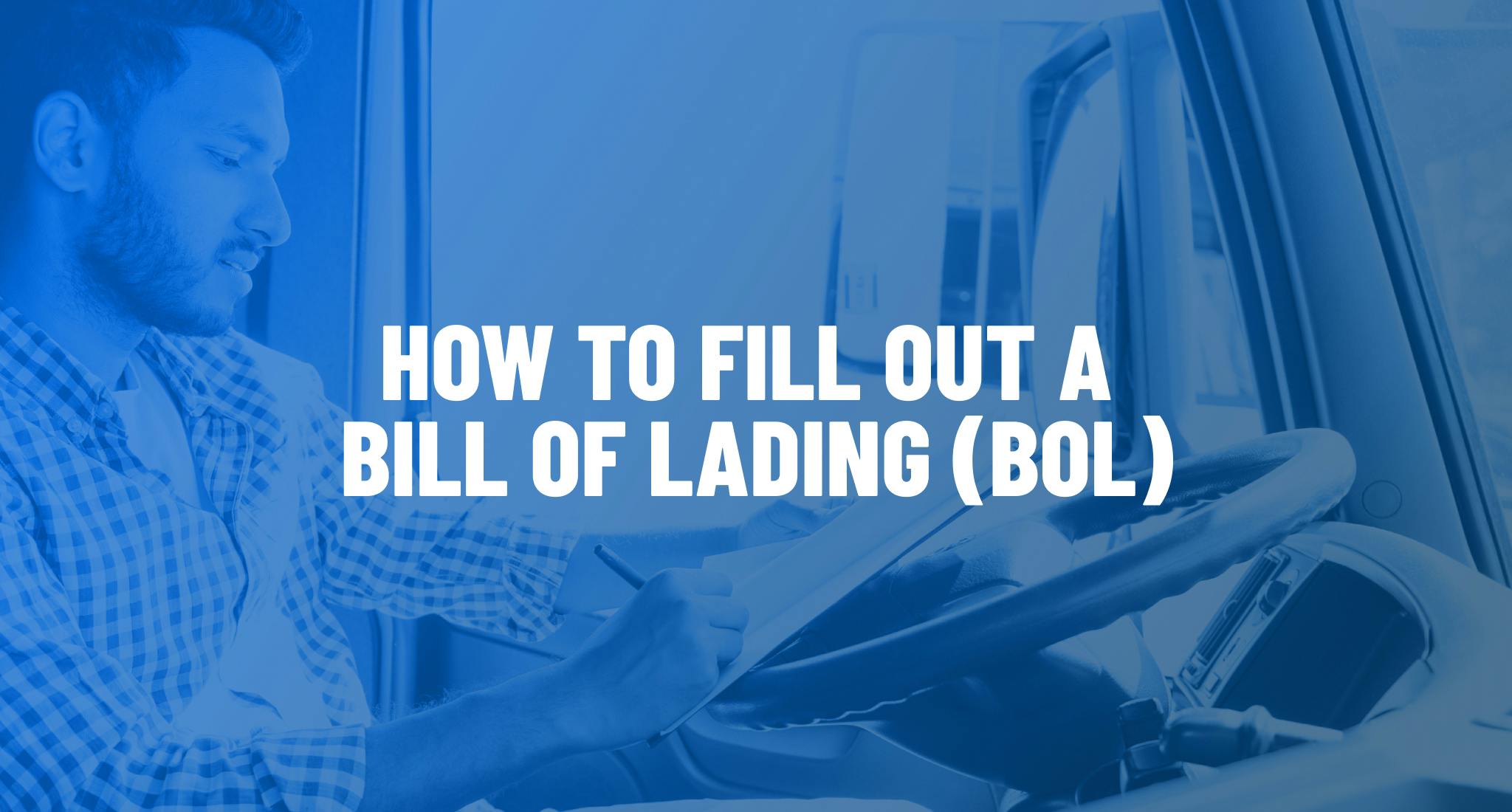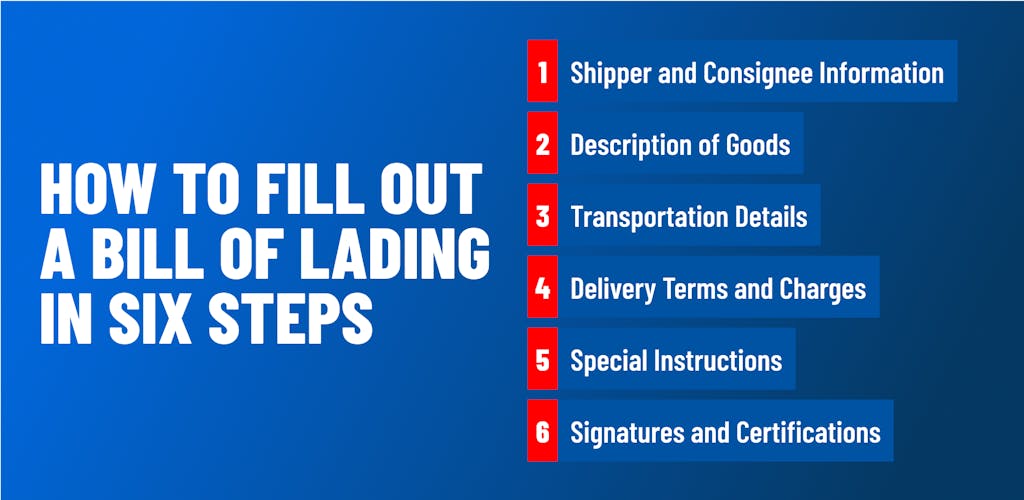How to Fill out a Bill of Lading (BoL)
January 15th, 2024

Filling out a Bill of Lading (BoL) correctly is a crucial process in the shipping and logistics industry. Bills of lading are legal documents that serve as a contract between the shipper and the carrier, outlining the details of the shipment, the terms of transportation, and the responsibilities of each party.
A properly completed BoL ensures that all parties have a clear understanding of the shipment, helps in tracking and managing the cargo, and is essential for resolving any disputes that may arise. It’s not just paperwork; it’s a vital tool for safeguarding your goods during transit.
This article will take a deep dive into everything you need to know about Bills of Lading and their role in the logistics industry.
What is a Bill of Lading
A Bill of Lading serves as a detailed receipt, a contract for carrying goods, and proof of receiving the goods in good condition by the carrier. Shippers or their agents typically create a Bill of Lading when sending a shipment. These documents contain all of the shipment’s essential information like shipper, carrier, and consignee details, a description of the shipped goods, quantity, weight, and packaging specifics.
A Bill of Lading plays multiple roles at various stages of a shipment. It acts as a receipt when the carrier collects the goods, a contract during transit, and proof of delivery upon reaching the destination. These critical documents are the glue that holds the shipping industry together, and they play an essential role in the movement of goods around the world.
The Importance of a Bill of Lading
The bill of lading is not merely a formality; it’s a cornerstone of efficient and responsible logistics. Here’s what they provide:
- Clarity and Agreement: The BOL serves as a legally binding contract, establishing clear expectations and minimizing the risk of disputes. It defines the precise terms of the shipment, including origin, destination, cargo description, cost, and delivery timeframe.
- Transparency and Accountability: The BOL functions as a detailed record of the cargo, offering a comprehensive inventory of items shipped, their weights and dimensions, and any specific handling requirements.
- Streamlined Communication: The BOL acts as a communication hub, ensuring all parties involved in the shipment stay informed and aligned. It serves as a shared reference point for customs officials, insurance providers, and regulatory bodies, facilitating smooth clearance and minimizing delays.
Overall, the bill of lading plays a crucial role in mitigating risks, streamlining processes, and guaranteeing the secure and efficient transportation of your valuable goods. It’s a powerful tool that safeguards everyone involved, from the shipper to the final recipient.
What a BoL Number Means
A BoL number performs a couple of key functions, making it a key aspect of the shipping and logistics world like a social security number for your package, a BoL number guides goods from origin to destination. Here’s why they’re so important:
- Unmistakable Identification: In a sea of containers and pallets, the BOL number acts as the sole, distinct identifier for your shipment. It allows for immediate recognition and differentiation, preventing confusion and misplacement.
- Efficient Tracing and Tracking: From warehouse to port, truck to rail, and beyond, the BOL number enables seamless tracking of your cargo’s whereabouts. With a BoL number, you can monitor your package’s progress in real-time, anticipate arrival dates, and proactively address any potential delays or disruptions.
- Streamlined Communication: The BOL number is a common reference point for all parties involved in the shipment—shippers, carriers, consignees, customs officials, and more. It facilitates clear and efficient communication, ensuring everyone is on the same page and working in sync.
- Simplified Record-Keeping: The BOL number simplifies record-keeping and filing for both shippers and carriers. It allows for effortless retrieval of shipment details, historical data analysis, and efficient management of past and ongoing transactions.
Bill of Lading Instructions: Step-by-Step Guide on How to Fill Out a Bill of Lading

Navigating the bill of lading can initially seem complex, but this step-by-step guide will walk you through it. Before proceeding, it is crucial to select the appropriate type of bill of lading, such as straight, order, or negotiable BOL, depending on the specific requirements of your shipment.
It’s also a good idea to ensure that you have all the essential information readily available, including details about the shipper and consignee, cargo descriptions, weights, dimensions, and any specific handling instructions.
Once you’ve assembled everything, you can start filling out the form:
Step 1: Shipper and Consignee Information
Shipper: Identify yourself, including your full name, company name (if applicable), and contact information.
Consignee: Provide the recipient’s complete details, including full name, company name (if applicable), and contact information.
Step 2: Description of Goods
Specificity is key: Provide a detailed description of each item being shipped, including type, quantity, weight, and dimensions. Use proper packaging terminology (e.g., cartons, pallets) and any identifying marks or numbers.
Declare the value: Be accurate and specific about the declared value of the goods for insurance purposes.
Step 3: Transportation Details
Origin and Destination: Clearly state the shipment’s point of origin and final destination.
Route: If specified, indicate the agreed-upon transportation route for the shipment.
Step 4: Delivery Terms and Charges
Incoterms: Choose the appropriate Incoterm (International Commercial Terms) to define responsibilities for costs and risks during transport.
Payment terms: Specify the agreed-upon payment method for freight charges, whether prepaid, collect, or third-party billing.
Step 5: Special Instructions
Handling notes: Communicate any specific handling requirements for your cargo, such as temperature control, fragile items, or stacking limitations.
Additional information: Include any other relevant details necessary for smooth delivery, like permits, customs documentation, or insurance certificates.
Step 6: Signatures and Certifications
Review and confirm: Carefully review all information entered before signing and dating the BOL.
Obtain signatures: Ensure both the shipper and carrier representative sign the BOL to acknowledge its terms and conditions.
Remember, this is a general guide, and specific fields or sections may vary depending on the chosen BOL type. Always consult the specific BOL template or your logistics provider for detailed instructions and additional requirements.
Bill of Lading Example
A Bill of Lading (BOL) is a critical document in shipping and logistics. Here’s a detailed example, along with an explanation of its various sections and fields:
Section 1: Shipper and Consignee Information
- Shipper: John Smith (Shipper’s Name)
- Company: ABC Manufacturing (if applicable)
- Address: 123 Main Street, Anytown, USA
- Contact: Phone: (555) 123-4567, Email: john.smith@example.com
- Consignee: Lisa Johnson (Consignee’s Name)
- Company: XYZ Retailers (if applicable)
- Address: 456 Elm Avenue, Other City, USA
- Contact: Phone: (555) 987-6543, Email: lisa.johnson@example.com
Section 2: Description of Goods
- Goods Description: 100 Cartons of Electronics
- Specifics: These are electronic gadgets such as smartphones, laptops, and tablets.
- Quantity: 100 cartons
- Weight: 500 kg
- Dimensions: 120 cm x 80 cm x 60 cm per carton
- Identifying Marks: Carton numbers from 001 to 100
- Declared Value: $50,000 (The value of the goods for insurance purposes)
Section 3: Transportation Details
- Origin: Los Angeles, California, USA
- Destination: New York City, New York, USA
- Route: West Coast to East Coast via Interstate 80
Section 4: Delivery Terms and Charges
- Incoterms: FOB (Free On Board) – The shipper is responsible for costs and risks until the goods are loaded onto the carrier.
- Payment Terms: Prepaid – The shipper has already paid the freight charges.
Section 5: Special Instructions
- Handling Notes: Fragile – Handle with care, avoid stacking, and keep away from extreme temperatures.
- Additional Information: The shipment requires customs documentation for international transit.
Section 6: Signatures and Certifications
- Review and Confirm: Both the shipper, John Smith, and the carrier representative, Mark Johnson, have reviewed the BOL and confirmed its accuracy.
- Signatures: Both parties have signed and dated the BOL.
Keep in mind that specific BOL templates may have variations, so it’s essential to use the appropriate form provided by your logistics provider or industry standards.
Frequently Asked Questions
How do you fill out a straight bill of lading?
Filling out a straight bill of lading involves providing your contact information as the shipper, including your name and address, and inputting the consignee’s details. Describe the goods, specifying quantity, weight, dimensions, and their declared value for insurance. Indicate the origin, destination, transportation route, incoterms, and payment terms. Note any special instructions and obtain signatures from the shipper and carrier representative.
How do I enter a bill of lading?
To enter a bill of lading, obtain a form from your logistics provider or use online templates. Input the shipper’s and consignee’s details, describe the goods, specify transportation and terms. Review for accuracy and obtain signatures from the shipper and carrier representative.
Can I make my own bill of lading?
Yes, you can create your bill of lading using a standard template, ensuring it includes essential information and adheres to legal and industry standards. Industry-standard forms are recommended for compliance. Ensure your custom bill complies with legal and industry requirements to avoid issues during shipping and logistics.
Learn more with Hale Trailer
Hale Trailer is your trusted partner for all your shipping and logistic needs. With a wide inventory of trailers and container chassis, we are well-equipped to meet your unique transportation requirements.
If you have any questions about trailer solutions, contact our sales team for expert guidance and recommendations tailored to your specific needs. If you’re in the neighborhood, visit one of our physical locations, where you can see our extensive inventory firsthand and experience the Hale Trailer difference.
All the information on this website – https://www.haletrailer.com – is published in good faith and for general information purposes only. Hale Trailer Brake and Wheel does not make any warranties about the completeness, reliability and accuracy of this information. Any action you take upon the information you find on this website, is strictly at your own risk. Hale Trailer Brake and Wheel will not be liable for any losses and/or damages in connection with the use of our website.
